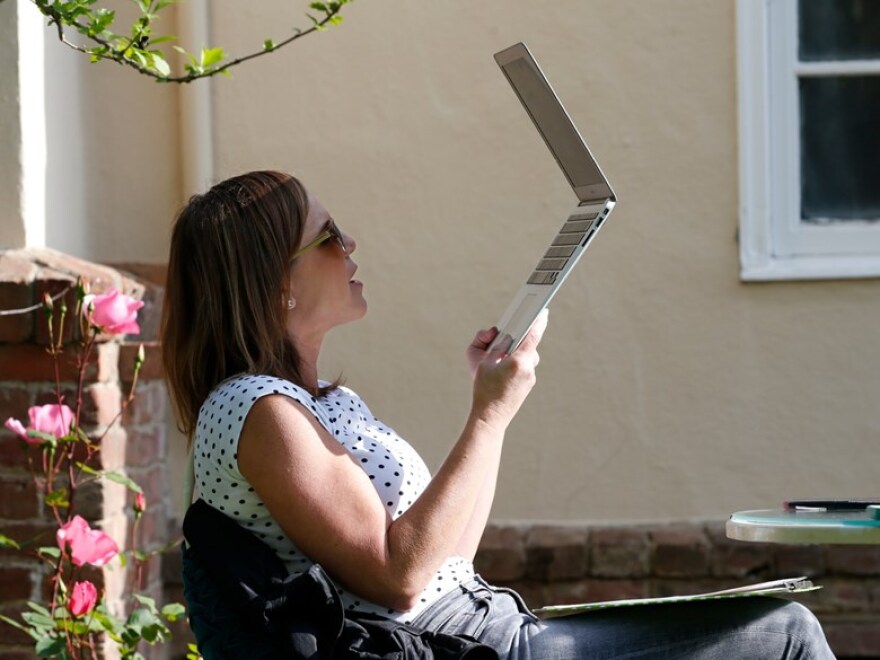The day Greenville Junior/Senior High School switched to distance learning, no students were in the classroom. They’d been off for three snow days, which meant the school didn’t have time to prepare and most students had left their school-issued tablets behind.
A challenge greater than finding and delivering those devices to students? Getting them online.
Traci Cockerill, principal of Greenville Junior/Senior High, says that in rural Plumas County, even she doesn’t have internet at home.
“I run my computer off my hotspot on my phone, and so that’s true for a lot of our families,” Cockerill said.
The spotty cell phone and internet service has made distance learning during the pandemic very challenging for the area, Cockerill said.
For students without internet, the school first handed out paper packets, but they also got some help from a nonprofit called Devices for Students and Verizon, which provided limited free internet service and data to some families, and also supplied the school with mobile hotspots.
But Cockerill says it’s not as easy as plug-and-play, and that students often have to search in the home, or go outside, to find a connection.
“I have one family who told me they would actually take the device and could go up to the lake and it would work at the lake but it wouldn’t work at their house,” she said.
This coming year, the principal hopes Verizon will help again. She also hopes the school will set up some sort of learning center, on the school grounds, where students can physically distance and access the internet, because it’s one of the only places in the community that has a reliable connection.
The internet access is so good, Cockerill says Feather River College asked if its students could park in the Greenville’s lot and do their work.
For parents and students, switching to distance learning has not been easy.
Mary Joseph, executive director of Roundhouse Council Indian Education Center, says she and her nine-year-old daughter, Kallie Merino, who attends Greenville Elementary School, occasionally use Zoom, which takes up a lot of bandwidth and can worsen a connection.
“The teacher would freeze and then she’d come back on, ’cause the internet is slow,” Joseph said about their Zoom experience.
“It’s really slow when everybody’s on the internet,” Merino added.
It’s been especially tough for Joseph’s high schoolers, who often need to be online at the same time. They even have issues with their devices echoing if they’re working in the same room. When one moves to a separate part of the house, they’d usually lose connection.
For Merino, who will enter fourth grade this year, the difficulties are less about her not having a good internet connection, but that her friends don’t.
“Because with social distancing, that means I can’t see my friends or see my teacher except on Zoom,” she said. “And most of my class, they can’t get onto Zoom, so I don’t even see most of my friends.”
She says out of her class of 20, about 10 or 15 would be able to connect.
Distance learning has been hard for teachers, too.
Caroline “Cali” Griffin teaches agricultural education at Loyalton High School in Sierra County. She thinks students there might have even fewer internet options, because, with a county population of 3,000, her students are very spread out.
Griffin says there were internet-access issues in her school before the pandemic, so students would come in early or during lunch to get online.
One possible solution in other communities is putting a hot spot on a bus and driving to where students live.
“But our kids are so dispersed, that really was not feasible for us,” Griffin said.
Now, she’s been telling her students to go to the school and sit in the parking lot to access the internet, she said.
“But then you have kids that don’t drive. How are they going to get there when their parents are trying to work?” Griffin said.
Kevin Bean is the director of student services for special education, English language learners and foster youth at Plumas Unified School District, and he has been thinking about that question a lot.
Where he works in Quincy, the connection is reliable enough. But many students, families and teachers live in more secluded areas without high-speed internet. In part, that's because it’s expensive for providers to build the infrastructure, especially for a limited number of customers.
“I think it’s going to take some initiative from state and federal authorities to nudge wireless companies along,” Bean said.
So far, there’s no real solution to improving internet access in Plumas and Sierra counties.
The Plumas Unified School District board of trustees voted on August 4 to continue with distanced learning at the end of this month and is exploring in-person learning hubs.
Traci Cockerill, the principal, is surveying students and families this week to plan for the fall around their needs.
“We weren’t planning in February or March that we were changing the whole system,” she said.
Despite the uncertainty, she sees an opportunity to think outside the box in the transition.
“We’re just starting to really look at what this can do and what it can bring to our kids.”
Correction: An earlier version of this story reported that Plumas Unified School District planned to return to in-person instruction in the fall. The board of trustees has since voted to continue distance learning in the fall, with special exceptions for certain students.



